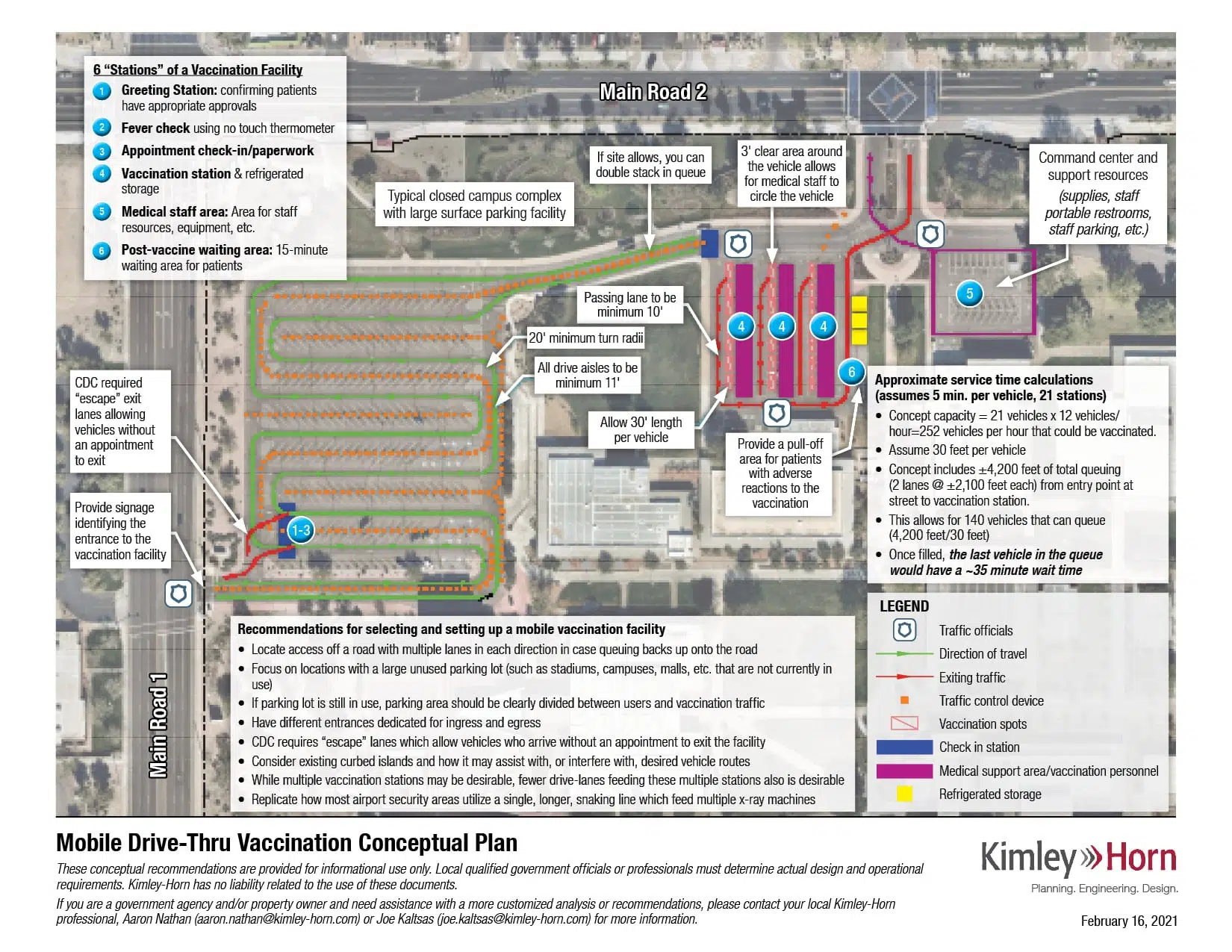- October 22, 2020
- COVID-19, Perspectives, Trending Topics
Best Practices for Setting Up COVID-19 Vaccination Facilities
How to Prepare a Drive-Thru or Mobile Site for Administering the COVID-19 Vaccine
Last Updated On: February 24, 2021
As manufacturers of the coronavirus vaccine scale up production, healthcare organizations are planning ways to distribute the vaccine effectively and safely to millions of Americans. Operational flow is a key part of setting up COVID-19 vaccination sites and the following best practices can be implemented to make operations more efficient.
This conceptual plan is based on the latest information available and subject to future changes in government guidelines.
Selecting a COVID-19 Vaccination Site
While each location is unique and local conditions will vary, select a drive-thru vaccination site with an unused or underused parking lot, such as a campus, stadium, or mall. Larger parking lots can service more people. Smaller sites can be more conveniently located in communities, but the vaccination site capacity will be much lower.
If the selected parking lot is still in use, clearly divide parked cars and vaccination site traffic. Additionally, ensure the parking lot is accessible via a road with multiple lanes in case the queue causes traffic to back up onto the street. If on-street backup is likely, work with local traffic engineers and/or law enforcement officials to make appropriate accommodations.
The graphic above represents a conceptual/planning level traffic control schematic for a hypothetical mobile drive-thru vaccination facility within a large vacant parking lot or similar paved area.
Designing the Site Layout
1. Dedicate Entry and Exit Points
Dedicate each access point as either an entrance or an exit and provide clear signage. Best practices recommend “escape” lanes to allow vehicles without an appointment to exit the vaccination site without disrupting traffic flow.
2. Designate Drive Aisles
Drive aisles should be a minimum of 11 feet wide with a minimum turn radius of 20 feet to prevent collisions with other vehicles in the queue. All mobile vaccination facilities should be laid out with a one-way queue lane, while still allowing vehicles to exit the facility in an orderly fashion.
3. Position Stations Strategically
When determining the layout of the vaccination site, consider existing curbed islands and how they may either assist or interfere with desired vehicle routes.
The command center—where support staff, restrooms, medical resources, and additional supplies are stored—should be positioned within walking distance of the medical vaccination stations and near a facility exit so pedestrian traffic in and out does not interrupt the vehicle queue. Depending on the requirements of the vaccine, special attention to refrigeration/freezer facilities should be incorporated.
4. Configure the Vaccination Stations
While multiple stations may increase the efficiency of the COVID-19 mobile vaccination facility, limit the number of drive lanes feeding into the vaccination stations. When space permits, use a single, long, snaking lane—like in an airport security area—to feed multiple vaccination stations.
Allow a 30-foot length per vehicle as each pulls into a vaccination station. The passing lane for vehicles to pull up to an open station should be at least 10 feet wide.
Calculating Service Time
Calculate and communicate—through signage and online notice boards—approximate wait times to set expectations for visitors. In the conceptual diagram above, we assumed a service time of five minutes and 30 feet per vehicle. At a location with 21 stations and 4,200 feet of total queuing, we estimated that the last vehicle in a full queue would wait approximately 35 minutes. Use the following formula to determine appropriate wait times for your mobile vaccination site:
Volume of vehicles per hour
=
Number of Vaccination Stations
x
60 minutes per hour
# of minutes per vehicle
The time it takes for the last vehicle to get through a full queue
=
Total length of vehicle queue
Volume of vehicles per hour
Mobile vaccination facilities could be a critical part of the overall strategy to mitigate COVID-19’s impact on our communities. This conceptual information is focused on traffic control operation and traffic management recommendations and leaves the specific layout, design, medical operations, and detailed vaccination requirements to the medical professionals and qualified local government officials. As such, Kimley-Horn has no liability related to the use of this information or documents.
We are hopeful the best practices here will help communities around the country. If you are a government agency or property owner and need assistance on a specific site, please contact your Kimley-Horn partner or email Joe Kaltsas or Aaron Nathan.
Share This Post
Related Articles
Interested in connecting with Kimley-Horn about a potential project need outside of the United States?
Provide us a little information below and someone from our team will be in touch.

